Developers
Client SDKs
AMP
AMP SDK
Android
Initialization
Configuration
Network Security Configuration
Event Tracking
User Attributes
IDSync
Screen Events
Commerce Events
Location Tracking
Media
Kits
Application State and Session Management
Data Privacy Controls
Error Tracking
Opt Out
Push Notifications
WebView Integration
Logger
Preventing Blocked HTTP Traffic with CNAME
Workspace Switching
Linting Data Plans
Troubleshooting the Android SDK
API Reference
Upgrade to Version 5
Cordova
Cordova Plugin
Identity
Direct Url Routing
Direct URL Routing FAQ
Web
Android
iOS
iOS
Workspace Switching
Initialization
Configuration
Event Tracking
User Attributes
IDSync
Screen Tracking
Commerce Events
Location Tracking
Media
Kits
Application State and Session Management
Data Privacy Controls
Error Tracking
Opt Out
Push Notifications
Webview Integration
Upload Frequency
App Extensions
Preventing Blocked HTTP Traffic with CNAME
Linting Data Plans
Troubleshooting iOS SDK
Social Networks
iOS 14 Guide
iOS 15 FAQ
iOS 16 FAQ
iOS 17 FAQ
iOS 18 FAQ
API Reference
Upgrade to Version 7
React Native
Getting Started
Identity
Unity
Upload Frequency
Getting Started
Opt Out
Initialize the SDK
Event Tracking
Commerce Tracking
Error Tracking
Screen Tracking
Identity
Location Tracking
Session Management
Xamarin
Getting Started
Identity
Web
Initialization
Configuration
Content Security Policy
Event Tracking
User Attributes
IDSync
Page View Tracking
Commerce Events
Location Tracking
Media
Kits
Application State and Session Management
Data Privacy Controls
Error Tracking
Opt Out
Custom Logger
Persistence
Native Web Views
Self-Hosting
Multiple Instances
Web SDK via Google Tag Manager
Preventing Blocked HTTP Traffic with CNAME
Facebook Instant Articles
Troubleshooting the Web SDK
Browser Compatibility
Linting Data Plans
API Reference
Upgrade to Version 2 of the SDK
Alexa
API References
Data Subject Request API
Data Subject Request API Version 1 and 2
Data Subject Request API Version 3
Platform API
Key Management
Platform API Overview
Accounts
Apps
Audiences
Calculated Attributes
Data Points
Feeds
Field Transformations
Services
Users
Workspaces
Warehouse Sync API
Warehouse Sync API Overview
Warehouse Sync API Tutorial
Warehouse Sync API Reference
Data Mapping
Warehouse Sync SQL Reference
Warehouse Sync Troubleshooting Guide
ComposeID
Warehouse Sync API v2 Migration
Calculated Attributes Seeding API
Bulk Profile Deletion API Reference
Data Planning API
Group Identity API Reference
Custom Access Roles API
Pixel Service
Profile API
Audit Logs API
Events API
mParticle JSON Schema Reference
IDSync
Quickstart
Android
Overview
Step 1. Create an input
Step 2. Verify your input
Step 3. Set up your output
Step 4. Create a connection
Step 5. Verify your connection
Step 6. Track events
Step 7. Track user data
Step 8. Create a data plan
Step 9. Test your local app
iOS Quick Start
Overview
Step 1. Create an input
Step 2. Verify your input
Step 3. Set up your output
Step 4. Create a connection
Step 5. Verify your connection
Step 6. Track events
Step 7. Track user data
Step 8. Create a data plan
Python Quick Start
Step 1. Create an input
Step 2. Create an output
Step 3. Verify output
Server SDKs
Node SDK
Go SDK
Python SDK
Ruby SDK
Java SDK
Guides
Partners
Introduction
Outbound Integrations
Outbound Integrations
Firehose Java SDK
Inbound Integrations
Compose ID
Glossary
Migrate from Segment to mParticle
Migrate from Segment to mParticle
Migrate from Segment to Client-side mParticle
Migrate from Segment to Server-side mParticle
Segment-to-mParticle Migration Reference
Data Hosting Locations
Rules Developer Guide
API Credential Management
The Developer's Guided Journey to mParticle
Guides
Composable Audiences
Composable Audiences Overview
User Guide
User Guide Overview
Warehouse Setup
Warehouse Setup Overview
Audience Setup
Frequently Asked Questions
Customer 360
Overview
User Profiles
Overview
User Profiles
Group Identity
Overview
Create and Manage Group Definitions
Calculated Attributes
Calculated Attributes Overview
Using Calculated Attributes
Create with AI Assistance
Calculated Attributes Reference
Getting Started
Create an Input
Start capturing data
Connect an Event Output
Create an Audience
Connect an Audience Output
Transform and Enhance Your Data
Platform Guide
Billing
Usage and Billing Report
The New mParticle Experience
The new mParticle Experience
The Overview Map
Observability
Observability Overview
Observability User Guide
Observability Troubleshooting Examples
Observability Span Glossary
Platform Settings
Audit Logs
Key Management
Platform Configuration
Event Match Quality Dashboard (Early Access)
Event Forwarding
Notifications
System Alerts
Trends
Introduction
Data Retention
Data Catalog
Connections
Activity
Data Plans
Live Stream
Filters
Rules
Blocked Data Backfill Guide
Tiered Events
mParticle Users and Roles
Analytics Free Trial
Troubleshooting mParticle
Usage metering for value-based pricing (VBP)
IDSync
IDSync Overview
Use Cases for IDSync
Components of IDSync
Store and Organize User Data
Identify Users
Default IDSync Configuration
Profile Conversion Strategy
Profile Link Strategy
Profile Isolation Strategy
Best Match Strategy
Aliasing
Segmentation
Audiences
Audiences Overview
Create an Audience
Connect an Audience
Manage Audiences
Audience Sharing
Match Boost
FAQ
Classic Audiences
Standard Audiences (Legacy)
Predictive Audiences
Predictive Audiences Overview
Using Predictive Audiences
New vs. Classic Experience Comparison
Analytics
Introduction
Core Analytics (Beta)
Setup
Sync and Activate Analytics User Segments in mParticle
User Segment Activation
Welcome Page Announcements
Settings
Project Settings
Roles and Teammates
Organization Settings
Global Project Filters
Portfolio Analytics
Analytics Data Manager
Analytics Data Manager Overview
Events
Event Properties
User Properties
Revenue Mapping
Export Data
UTM Guide
Analyses
Analyses Introduction
Segmentation: Basics
Getting Started
Visualization Options
For Clauses
Date Range and Time Settings
Calculator
Numerical Settings
Segmentation: Advanced
Assisted Analysis
Properties Explorer
Frequency in Segmentation
Trends in Segmentation
Did [not] Perform Clauses
Cumulative vs. Non-Cumulative Analysis in Segmentation
Total Count of vs. Users Who Performed
Save Your Segmentation Analysis
Export Results in Segmentation
Explore Users from Segmentation
Funnels: Basics
Getting Started with Funnels
Group By Settings
Conversion Window
Tracking Properties
Date Range and Time Settings
Visualization Options
Interpreting a Funnel Analysis
Funnels: Advanced
Group By
Filters
Conversion over Time
Conversion Order
Trends
Funnel Direction
Multi-path Funnels
Analyze as Cohort from Funnel
Save a Funnel Analysis
Explore Users from a Funnel
Export Results from a Funnel
Saved Analyses
Manage Analyses in Dashboards
Query Builder
Data Dictionary
Query Builder Overview
Modify Filters With And/Or Clauses
Query-time Sampling
Query Notes
Filter Where Clauses
Event vs. User Properties
Group By Clauses
Annotations
Cross-tool Compatibility
Apply All for Filter Where Clauses
Date Range and Time Settings Overview
User Attributes at Event Time
Understanding the Screen View Event
User Aliasing
Dashboards
Dashboards––Getting Started
Manage Dashboards
Dashboard Filters
Organize Dashboards
Scheduled Reports
Favorites
Time and Interval Settings in Dashboards
Query Notes in Dashboards
Analytics Resources
The Demo Environment
Keyboard Shortcuts
User Segments
Data Privacy Controls
Data Subject Requests
Default Service Limits
Feeds
Cross-Account Audience Sharing
Import Data with CSV Files
Import Data with CSV Files
CSV File Reference
Glossary
Video Index
Analytics (Deprecated)
Identity Providers
Single Sign-On (SSO)
Setup Examples
Introduction
Developer Docs
Introduction
Integrations
Introduction
Rudderstack
Google Tag Manager
Segment
Data Warehouses and Data Lakes
Advanced Data Warehouse Settings
AWS Kinesis (Snowplow)
AWS Redshift (Define Your Own Schema)
AWS S3 Integration (Define Your Own Schema)
AWS S3 (Snowplow Schema)
BigQuery (Snowplow Schema)
BigQuery Firebase Schema
BigQuery (Define Your Own Schema)
GCP BigQuery Export
Snowflake (Snowplow Schema)
Snowplow Schema Overview
Snowflake (Define Your Own Schema)
Developer Basics
Aliasing
Integrations
ABTasty
Audience
24i
Event
Aarki
Audience
Actable
Feed
AdChemix
Event
Adobe Marketing Cloud
Cookie Sync
Server-to-Server Events
Platform SDK Events
Adobe Audience Manager
Audience
Adobe Campaign Manager
Audience
AdMedia
Audience
Adobe Experience Platform
Event
Adobe Target
Audience
AdPredictive
Feed
AgilOne
Event
Algolia
Event
Amazon Kinesis
Event
Amazon Advertising
Audience
Amazon S3
Event
Amazon Redshift
Data Warehouse
Amazon SNS
Event
Amazon SQS
Event
Amobee
Audience
Anodot
Event
Antavo
Feed
Apptentive
Event
Apptimize
Event
Awin
Event
Apteligent
Event
Microsoft Azure Blob Storage
Event
Bing Ads
Event
Bidease
Audience
Bluecore
Event
Bluedot
Feed
Branch S2S Event
Event
Bugsnag
Event
Census
Feed
Cadent
Audience
comScore
Event
Conversant
Event
Custom Feed
Custom Feed
Crossing Minds
Event
Databricks
Data Warehouse
Datadog
Event
Didomi
Event
Eagle Eye
Audience
Emarsys
Audience
Edge226
Audience
Epsilon
Event
Everflow
Audience
Facebook Offline Conversions
Event
Flurry
Event
Google Analytics for Firebase
Event
Flybits
Event
FreeWheel Data Suite
Audience
ForeSee
Event
Friendbuy
Event
Google Ad Manager
Audience
Google Analytics
Event
Google Analytics 4
Event
Google BigQuery
Audience
Data Warehouse
Google Enhanced Conversions
Event
Google Marketing Platform
Audience
Cookie Sync
Event
Google Pub/Sub
Event
Google Marketing Platform Offline Conversions
Event
Google Tag Manager
Event
Herow
Feed
Hightouch
Feed
Ibotta
Event
ID5
Kit
Heap
Event
Hyperlocology
Event
Impact
Event
InMarket
Audience
Inspectlet
Event
Intercom
Event
ironSource
Audience
Kafka
Event
Kissmetrics
Event
LaunchDarkly
Feed
Kubit
Event
LifeStreet
Audience
LiveLike
Event
Liveramp
Audience
Localytics
Event
mAdme Technologies
Event
MadHive
Audience
Marigold
Audience
Microsoft Azure Event Hubs
Event
Mediasmart
Audience
Microsoft Ads
Microsoft Ads Audience Integration
MediaMath
Audience
Mintegral
Audience
Monetate
Event
Movable Ink
Event
Movable Ink - V2
Event
Multiplied
Event
Nami ML
Feed
Nanigans
Event
NCR Aloha
Event
OneTrust
Event
Neura
Event
Oracle BlueKai
Event
Paytronix
Feed
Personify XP
Event
Persona.ly
Audience
Plarin
Event
Primer
Event
Quantcast
Event
Qualtrics
Event
Rakuten
Event
Regal
Event
Reveal Mobile
Event
RevenueCat
Feed
Salesforce Mobile Push
Event
Scalarr
Event
SimpleReach
Event
Shopify
Custom Pixel
Feed
Singular-DEPRECATED
Event
Skyhook
Event
Smadex
Audience
SmarterHQ
Event
Slack
Event
Snapchat Conversions
Event
Snowflake
Data Warehouse
Snowplow
Event
Splunk MINT
Event
StartApp
Audience
Talon.One
Event
Audience
Feed
Loyalty Feed
Tapad
Audience
Tapjoy
Audience
Taptica
Audience
Taplytics
Event
The Trade Desk
Cookie Sync
Audience
Event
Teak
Audience
Ticketure
Feed
Triton Digital
Audience
TUNE
Event
Valid
Event
Vkontakte
Audience
Vungle
Audience
Webhook
Event
Webtrends
Event
Wootric
Event
Yotpo
Feed
White Label Loyalty
Event
Xandr
Cookie Sync
Audience
YouAppi
Audience
Yahoo (formerly Verizon Media)
Audience
Cookie Sync
Observability User Guide
The Trace Activity page in the Observability tool is where you can:
To learn more about the information that traces that provide, see trace details.
To navigate to Observability:
- Log in to your mParticle account.
- From the overview map, select Observability within the Oversight suite or go to Oversight > Observability > Trace Activity using the left hand nav.
- This brings you to the Trace Activity page.

You can also jump directly to Observability by clicking the Search icon in the left nav bar (or entering Cmd+K on MacOS or Ctrl+K on Windows) and searching for “Observability”.
View all trace activity
The Trace Activity page displays a list of all recent traces for your development data, and any traces you have configured for your production data. All traces are available for up to 14 days.
To view the details for a specific trace, click the purple ID under the Trace ID column.
Trace status
You can access a trace from Observability as soon as mParticle begins receiving and processing data, but it’s important to note that a trace can’t provide complete information about a data flow until all data in the trace has been fully processed. This typically occurs within 30 minutes.
Traces that are ready to be used for troubleshooting will display a “Complete” Trace Status on the Trace Details Page. Traces for data flows that are still being processed have a Trace Status of “In Progress”.
Sort and filter trace activity
You can filter your results by time frame by clicking the button labeled “Last hour” and selecting one of the predefined date ranges or entering a custom range.
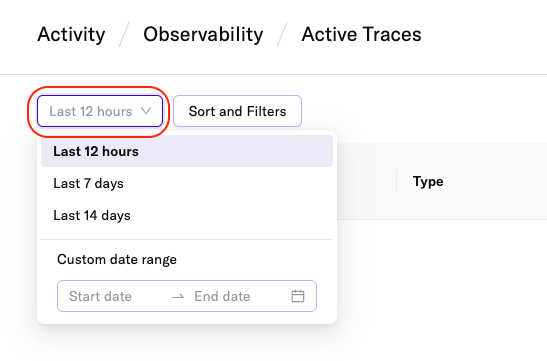
To further sort and filter your results, click Sort and Filters to view the following options:
Sort traces
Use the Order dropdown menu to sort your traces from most recent to oldest, or oldest to most recent.
Filter traces
Under Filters, select any of the following criteria to limit the traces displayed:
-
Trace Type:
- Event: displays only traces for the Events API
- Identity: displays only traces for the IDSync API
-
Result:
- Success: displays only traces where all data was processed without any issues.
- Insight: includes traces that experienced an interruption in data flow resulting from a configuration setting (such as a Rule or Filter).
- Needs Attention: displays only traces that include an error message.
- Warning: includes traces where an issue was encountered during data processing that could be resolved with a retry.
-
Environment:
- Production: displays only traces for data in your Production environment
- Development: displays only traces for data in your Development environment
- mPID: filters results based on the MPID associated with a call to the IDSync API
- Trace Configuration ID: displays only traces created for the given trace configuration ID
- Inputs: filters results based on one of your configured data inputs
- Outputs: filters results based on one of your configured data outputs
After selecting your desired sorting and filter options, click Apply. This refreshes the Trace Activity page to display only filters matching your selected criteria.
Customize trace activity page
You can configure the columns that are displayed on the trace activity page by clicking the View Columns button.

To remove a column from the trace activity page, click the toggle switch. Some columns, like “Trace ID”, cannot be removed.
To change the order of the columns, click and drag the handle next to the column name.

Trace details
After opening the details page for a specific trace, you will see the following information:
Trace summary
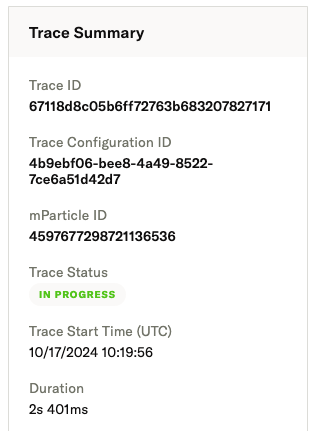
- Trace ID: the unique ID for the trace.
- Trace Configuration ID: the ID of the trace configuration that the trace belongs to.
- mParticle ID: any MPID that is associated with the trace.
- Trace Status: either “In Progress” or “Complete”. The trace status indicates whether a trace contains enough information for it to be useful when troubleshooting your data flow. Traces that are “In Progress” indicate that the data being traced is still being processed. For more information, see Trace status.
- Trace Start Time: the date and time (in UTC) when the data was initially received by the mParticle platform.
- Duration: the total time elapsed during the trace.
Setup details
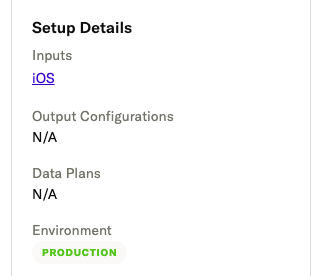
- Inputs: the name of the input configuration where the data originated.
- Output Configurations: the configured outputs for the data.
- Data plans: any active data plans that were used during processing.
- Environment: indicates whether the data flowed through your development or production environment.
Trace result
For each trace, you will see either Success, Insight, Needs Attention, or Warning displayed under “Result” along with any applicable messages under “Additional information”. You can use this information to determine whether an issue encountered during the trace was intentional or accidental, and what steps you may need to take to resolve any issues.
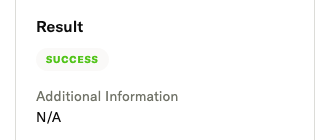
| Message | Description |
|---|---|
| Success | Your data was ingested, processed, and forwarded without encountering any issues. |
| Insight | Your data flow was interrupted due to a configuration setting (such as a Rule or Filter). These interruptions may or may not be intentional, depending on your configuration and desired behavior. Referring to any insights can be helpful in identifying unintended consequences of a configuration setting. |
| Warning | Indicates that an issue was encountered during data processing that could be resolved with a retry. |
| Needs Attention | An error was encountered during the trace that cannot be resolved with a retry. |
In some cases, you might see additional information with instructions to contact mParticle Support or your mParticle Account Representative, who can help you determine the root cause of an error or issue.
Related traces
It’s possible for one process to trigger other related processes in the mParticle platform. Any related processes that are traced will be listed here.
For example, when mParticle ingests a batch of event data or a request to make a bulk update to your data, each subsequent data flow will have its own unique trace, which you can find and access here.
Timeline view
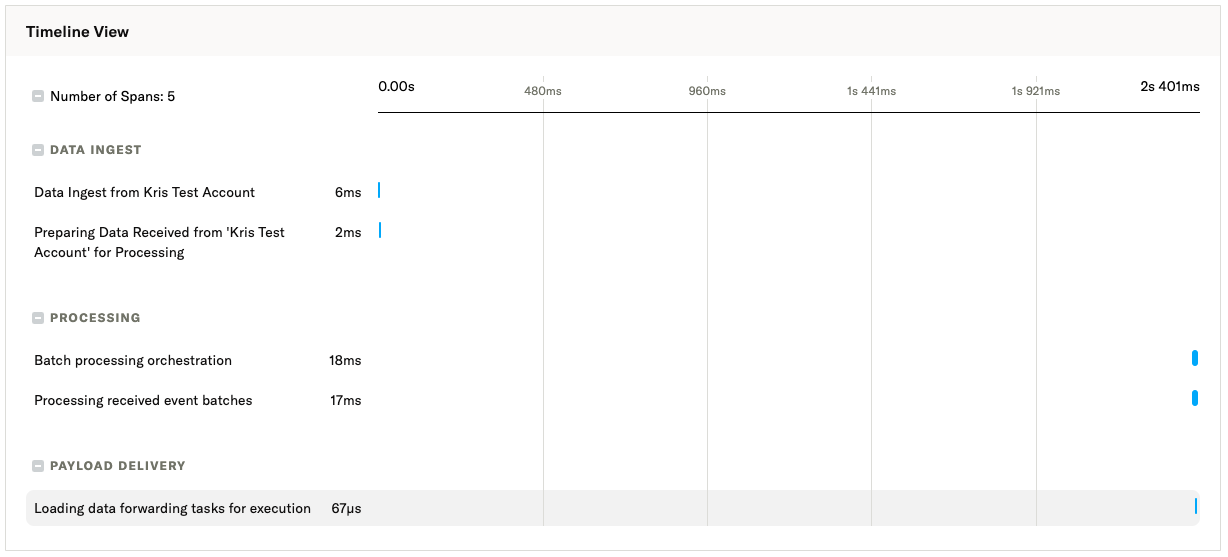
The Timeline View provides a visual picture of how your data flows through the mParticle platform, broken into different spans, with each span representing a different stage of data processing.
Hover your cursor over the span in the timeline to see its exact start and end times.
To view details for a specific span, click on the span within the timeline and review the information panel at the bottom of the UI.
Not all spans will be presented sequentially, and some will appear to occur at the same time.
This is because mParticle executes different processes in parallel to reduce the amount of time it takes to process your data. Most gaps between spans on your timeline are likely due to networking delays or internal processes that are not represented on the trace timeline.
Span details
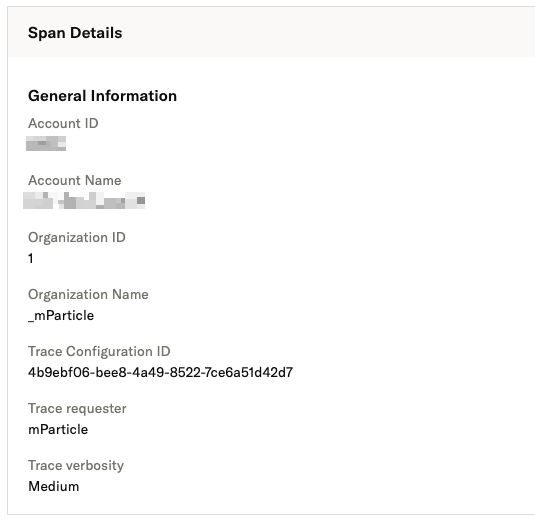
The Span Details view provides more granular information about a particular span. The details shown will vary depending on the span category.
To learn more about each span category, view the Span Glossary.
About trace IDs
Each individual trace is uniquely identified by a 36 character Trace ID resembling 66e0c0cd9bb8998a579595e42bae7077.
Trace IDs are essential for pinpointing specific data processing traces. You can find them in two primary ways:
1) Find a trace ID in an API response
Trace IDs are included with all responses to calls to the Events and IDSync APIs.
To find a trace ID in an API response:
- Search your API response for the header titled
X-MP-Trace-Id. The value of this header is the trace ID for the corresponding API call.

2) Find a trace ID in Live Stream
- Log into your mParticle account and navigate to Activity > Live Stream.
- Select any event row.
- In the right hand sidebar, you will find the trace ID associated with that event.
Search for a trace using a trace ID
To search for a specific trace on the Trace Activity page:
- Find and copy the trace ID from an API response or Live Stream as described in About trace IDs.
- Log into your mParticle account and navigate to Oversight > Observability > Trace Activity.
- From the Trace Activity page, enter your trace ID in the search bar and click Search.

Open a trace from Live Stream
You can also view trace details for a data flow directly from the mParticle Live Stream.
- Log into your mParticle account and navigate to Data Platform > Live Stream.
- Select the event row you want to view the trace for.
- In the right hand sidebar, you will find the trace ID associated with that event.
- Click on the Trace ID to open up the Trace Details page in the Observability suite.

Trace configurations
To view your trace configurations, navigate to Oversight > Observability > Trace Configurations in the left hand navigation.
You define what data you want to trace using a trace configuration. A trace configuration initiates an individual trace with a unique trace ID for each request to the Events or Identity API according to the trace configuration settings you specify.
The trace configurations page displays a list of all configurations, sorted from newest to oldest. You can see the start and end date and times for each configuration, the trace configuration ID, the percentage of data that will be traced, and one of the following trace configuration statuses:
- Active: Active trace configurations will generate a trace for any data ingested from the configured input(s).
- Pending: Pending trace configurations will become active once the selected start date and time is reached.
- Completed: Trace configurations are marked Completed when the scheduled duration for the trace has elapsed.
- Canceled: If you cancel the trace configuration, its status is changed to Canceled.

Create a trace configuration
To create a new trace configuration:
-
Navigate to Oversight > Observability > Trace Configurations, and click Create Trace Configuration.
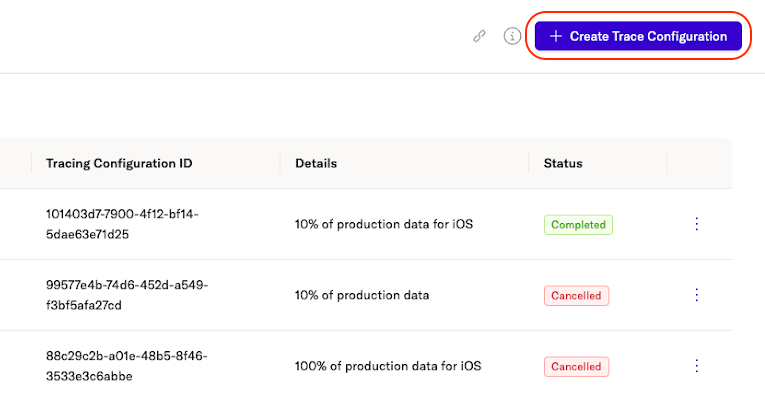
This opens the Add Tracing Configuration window:
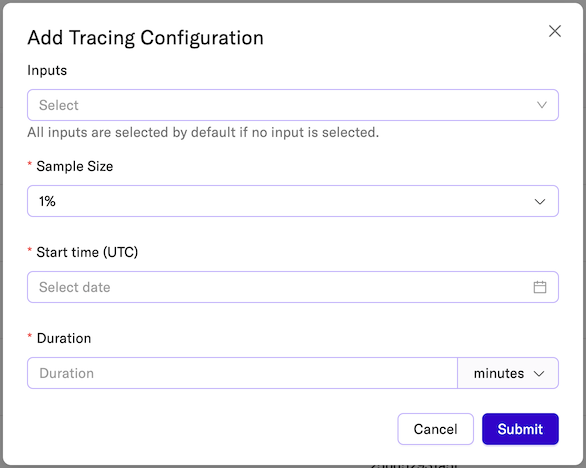
-
Under Inputs, select the connected data input you want to trace.
- You can select one of your configured Warehouse Sync pipelines as the input. Warehouse Sync pipelines will be listed under the Feeds input category.
-
Use the date and time picker to select the Start Date & Time and Duration for your trace. Traces will only be generated after the start time and for the duration you specify.
- If you select a Warehouse Sync pipeline as your input to trace, you will see a unique trace generated for each event batch within the timeframe you specify.
-
Select the percentage of your data you would like to be traced using the Sample Size drop down menu. You can select either 1%, 3%, or 5% for small sample sizes, or you can select 10% through 100% in increments of 10 for larger sample sizes.
- You should use large sample size for short-term tracing. For example, when first launching a new mParticle configuration, creating a short-term trace configuration with a large sample size can help you detect problems early on.
- You should use a small sample size for long-term tracing. For example, once you have a stable configuration but still want to monitor your data, you can create a long-term trace configuration with a small sample size to keep your tracing cost low.
- Use the date and time picker to select the Start Time (UTC) and Duration for your trace. Traces will only be generated after the start time and for the duration you specify.
- Click Submit.
After clicking Submit, you will see your new tracing configuration listed on the Trace Configurations page.
Was this page helpful?
- Last Updated: December 16, 2025